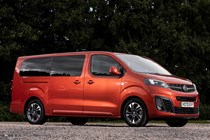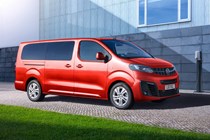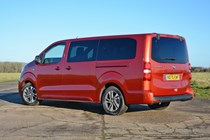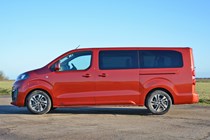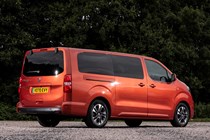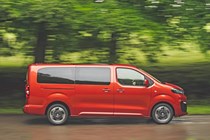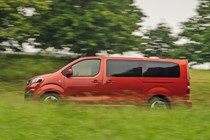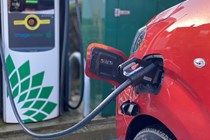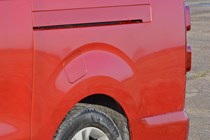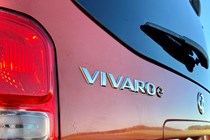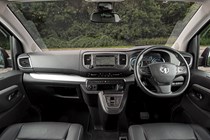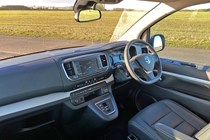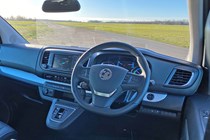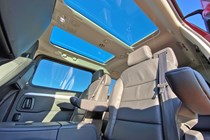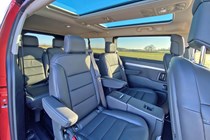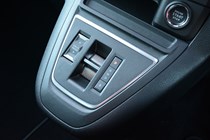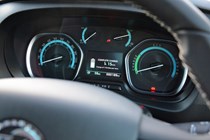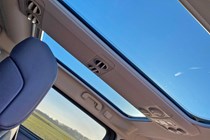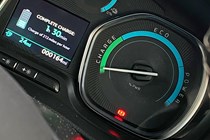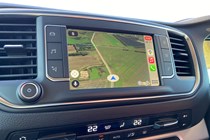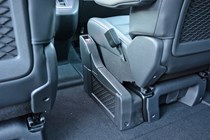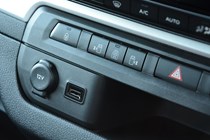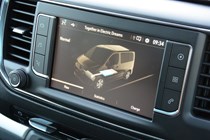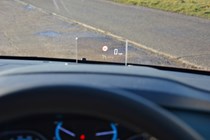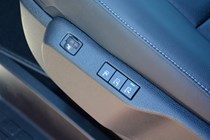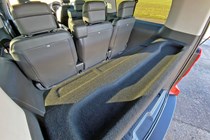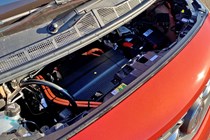
Vauxhall Vivaro-e Life boot space, practicality and safety
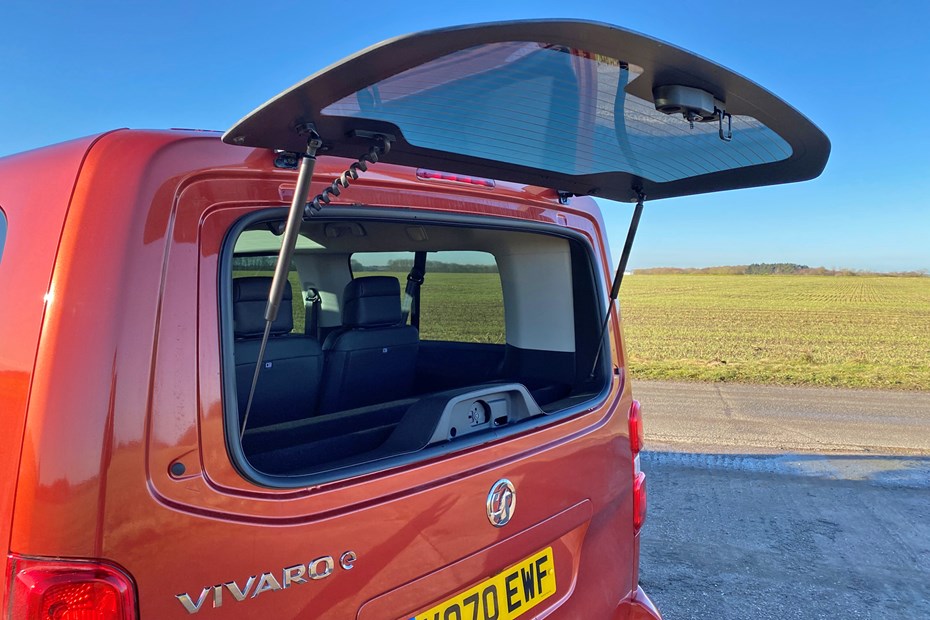
- Roomy interior, but more flexibility needed
- Sliding doors help prevent car park dings
- Charging port well-located for public chargers
How much space is there?
Loads. It’s a van. Because the Vivaro Life Electric’s battery pack is located under the floor, there’s no impact on space for passengers or luggage. That means there’s an identical amount of space inside to the diesel Vivaro Life.
However, the cabin could have been designed with a little more flexibility in mind. For example, the rearmost seat belts are mounted to the body rather than the seats, which limits the range of positions they can be slid into.
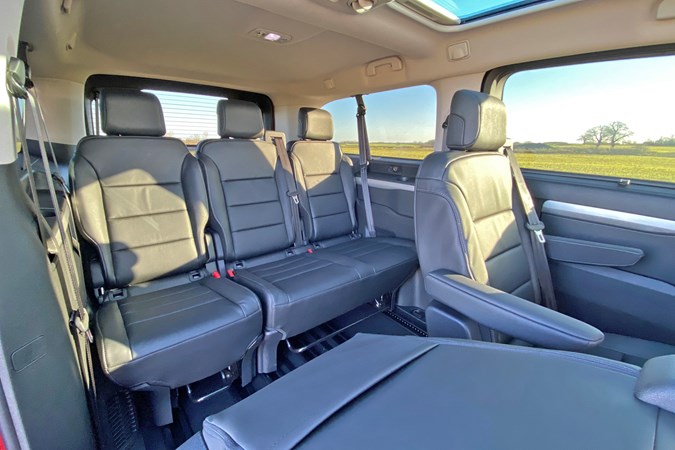
Compared with the Mercedes-Benz EQV (which has all of its belts mounted to the seats), the Vauxhall’s interior feels less spacious despite how massive it is inside. You don’t really notice this when all the seats are facing forwards, but if you spin the Vauxhall’s second row around to face the third, taller passengers will get their legs knotted up with those opposite.
At least access is good. The sliding rear doors are huge and, if you opt for the poshest Ultimate model, they’re electrically operated. Just push a button and they slide back like the bridge doors on the Starship Enterprise.
Boot space and storage
As we’ve mentioned, the Vivaro Life Electric is basically a van – so there’s loads of space in the back. If you want the maximum amount of storage space, though, you’ll need to remove the rear seats. But be prepared to eat your spinach and rope in a friend if you do because they’re heavy and difficult to lug about.
The Medium length model has a maximum storage volume of 3,900 litres, while the Long variant offers 4,500 litres. Even with the rear seats in place, though, the Long models still has 989 litres of space to the window line and 1,384 litres to the roof. Ultimate versions also have a parcel shelf, but it’s of limited use because it only covers half the space from the tailgate to the back of the third-row seats.
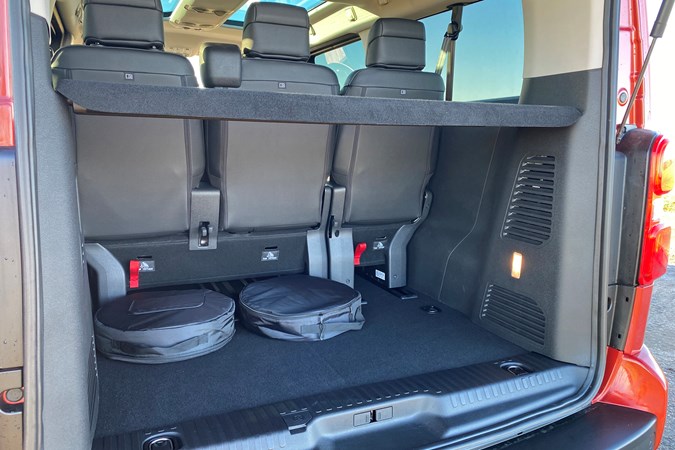
The Vivaro Life Electric also has a hinged rear window to all easier boot access in confined areas. The Mercedes EQV has the same system – but it also has an electrically assisted tailgate. The latter feature is something the Vauxhall does without. You need to impart a hearty heave to wrench it open.
Oddment storage could be better, too. The top of the dashboard has a couple of cupholders and some storage trays, but there’s isn’t a cubby large enough to hold a modern smartphone. That’s especially frustrating when you consider the only USB port up front is in the centre of the dash. However, your Vauxhall dealer can supply a dash-mounted smartphone cradle as an optional extra.
Is it easy to park?
The Vivaro Life Electric is a big vehicle, so don’t expect it to feel like a Ford Fiesta in a car park. There’s plenty of glass in the cabin, though, and the side mirrors are a good size, so it’s not as difficult to manoeuvre as you’d think.
If you’d like rear parking sensors, you’ll need to either shell out a bit more cash on the mid-range Design model or tick the right option box on your order form. Front parking sensors are a £390 optional extra regardless of the specification, while the range-topping Ultimate model comes with a panoramic rear view camera.
Safety
- Five-star Euro NCAP rating
- Ultimate models have more safety kit
- Additional equipment on option list
Euro NCAP hasn’t yet crash tested the Vauxhall Vivaro Life Electric or its mechanically identical electric siblings, the Peugeot e-Traveller and Citroen e-Spacetourer. However, the structurally equivalent diesel versions of the same vans all scored five stars when they were tested back in 2015.
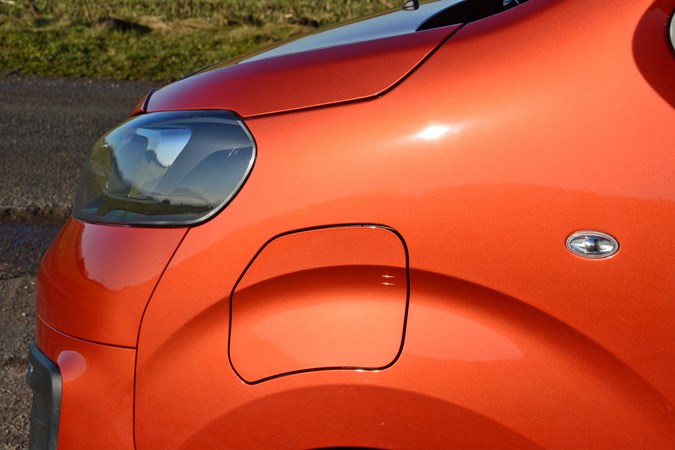
Standard safety equipment includes Electronic Stability Control (ESC) with traction control, an electronic parking brake, a tyre pressure monitoring system, hill start assist and up to 10 airbags, including side curtain airbags for front and rear seat passengers. The second seating row also features three sets of Isofix points.
If you feel you need some extra safety assistance, opt for either the Design or Ultimate specification. They both feature with Vauxhall’s Driver Assistance Pack as standard, which includes autonomous emergency braking, lane departure warning, a traffic sign recognition system and high beam assist.
Watch: Vauxhall Vivaro Life Electric’s sister car’s Euro NCAP crash test video
Euro NCAP rating
| What is Euro NCAP? ⓘ | |
|---|---|
| Adult Occupant: | 87% |
| Child Occupant: | 91% |
| Vulnerable Road User: | 64% |
| Safety Assist: | 78% |
Equipment and options
- 3x3 point rear seat belts
- ABS
- Driver`s airbag
- Electric mirrors
- Front electric windows
- Heated mirrors
- PAS
- Passenger`s airbag
- Remote locking
- Steering wheel rake adjustment
- Steering wheel reach adjustment
- Traction control
- Air conditioning
- Cloth seat trim
- Height adjustable drivers seat
- Isofix child seat anchor points
- Steel wheels
- Alarm
- Climate control
- Cruise control
- Folding rear seats
- Heated seats
- Parking sensors
- Side airbags
- Air conditioning
- Body coloured bumpers
- Cloth seat trim
- Front fog lights
- Height adjustable drivers seat
- Isofix child seat anchor points
- Parking sensors
- Steel wheels
- Alarm
- Climate control
- Cruise control
- Folding rear seats
- Heated seats
- Side airbags
- Air conditioning
- Alarm
- Cloth seat trim
- Cruise control
- Full size spare wheel
- Side airbags
- Steel wheels
- n/a
- Alarm
- Climate control
- Electric driver`s seat
- Electric passenger`s seat
- Front fog lights
- Heated seats
- Height adjustable drivers seat
- Isofix child seat anchor points
- Leather seat trim
- Lumbar support
- Parking sensors
- Sat Nav
- Side airbags
- Cruise control
- Full size spare wheel
- Body coloured bumpers
- Front fog lights
- Heated seats
- Height adjustable drivers seat
- Isofix child seat anchor points
- Leather seat trim
- Parking sensors
- Sat Nav
- Air conditioning
- Alarm
- Alloy wheels
- CD
- Cruise control
- Electric driver`s seat
- Folding rear seats
- Side airbags
Dimensions
| Length | 4956mm - 5309mm |
|---|---|
| Width | 2204mm |
| Height | 1890mm - 1935mm |


